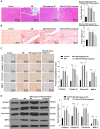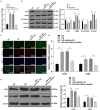MicroRNA-195-5p Downregulation Inhibits Endothelial Mesenchymal Transition and Myocardial Fibrosis in Diabetic Cardiomyopathy by Targeting Smad7 and Inhibiting Transforming Growth Factor Beta 1-Smads-Snail Pathway
- PMID: 34658906
- PMCID: PMC8514870
- DOI: 10.3389/fphys.2021.709123
MicroRNA-195-5p Downregulation Inhibits Endothelial Mesenchymal Transition and Myocardial Fibrosis in Diabetic Cardiomyopathy by Targeting Smad7 and Inhibiting Transforming Growth Factor Beta 1-Smads-Snail Pathway
Abstract
Diabetic cardiomyopathy (DCM) is a complication of diabetes mellitus, which is associated with fibrosis and microRNAs (miRs). This study estimated the mechanism of miR-195-5p in endothelial mesenchymal transition (EndMT) and myocardial fibrosis in DCM. After the establishment of DCM rat models, miR-195-5p was silenced by miR-195-5p antagomir. The cardiac function-related indexes diastolic left ventricular anterior wall (LVAW, d), systolic LVAW (d), diastolic left ventricular posterior wall (LVPW, d), systolic LVPW (d), left ventricular ejection fraction (LVEF), and fractional shortening (FS) were measured and miR-195-5p expression in myocardial tissue was detected. Myocardial fibrosis, collagen deposition, and levels of fibrosis markers were detected. Human umbilical vein endothelial cells (HUVECs) were exposed to high glucose (HG) and miR-195-5p was silenced. The levels of fibrosis proteins, endothelial markers, fibrosis markers, EndMT markers, and transforming growth factor beta 1 (TGF-β1)/Smads pathway-related proteins were measured in HUVECs. The interaction between miR-195-5p and Smad7 was verified. In vivo, miR-195-5p was highly expressed in the myocardium of DCM rats. Diastolic and systolic LVAW, diastolic and systolic LVPW were increased and LVEF and FS were decreased. Inhibition of miR-195-5p reduced cardiac dysfunction, myocardial fibrosis, collagen deposition, and EndMT, promoted CD31 and VE-cadehrin expressions, and inhibited α-SMA and vimentin expressions. In vitro, HG-induced high expression of miR-195-5p and the expression changes of endothelial markers CD31, VE-cadehrin and fibrosis markers α-SMA and vimentin were consistent with those in vivo after silencing miR-195-5p. In mechanism, miR-195-5p downregulation blocked EndMT by inhibiting TGF-β1-smads pathway. Smad7 was the direct target of miR-195-5p and silencing miR-195-5p inhibited EndMT by promoting Smad7 expression. Collectively, silencing miR-195-5p inhibits TGF-β1-smads-snail pathway by targeting Smad7, thus inhibiting EndMT and alleviating myocardial fibrosis in DCM.
Keywords: TGF-β1-smads-snail pathway; diabetic cardiomyopathy; endothelial mesenchymal transition; miR-195-5p; myocardial fibrosis; smad7.
Copyright © 2021 Ding, Yao, Xie, Wang, Chen, Wei, Ji and Liu.
Conflict of interest statement
The authors declare that the research was conducted in the absence of any commercial or financial relationships that could be construed as a potential conflict of interest.
Figures







Similar articles
-
MicroRNA-142-3p inhibits high-glucose-induced endothelial-to-mesenchymal transition through targeting TGF-β1/Smad pathway in primary human aortic endothelial cells.Int J Clin Exp Pathol. 2018 Mar 1;11(3):1208-1217. eCollection 2018. Int J Clin Exp Pathol. 2018. PMID: 31938215 Free PMC article.
-
The role of miR-328 in high glucose-induced endothelial-to-mesenchymal transition in human umbilical vein endothelial cells.Life Sci. 2018 Aug 15;207:110-116. doi: 10.1016/j.lfs.2018.05.055. Epub 2018 May 31. Life Sci. 2018. PMID: 29859985
-
MiR-200a modulates TGF-β1-induced endothelial-to-mesenchymal shift via suppression of GRB2 in HAECs.Biomed Pharmacother. 2017 Nov;95:215-222. doi: 10.1016/j.biopha.2017.07.104. Epub 2017 Sep 12. Biomed Pharmacother. 2017. PMID: 28846982
-
MicroRNA targets and biomarker validation for diabetes-associated cardiac fibrosis.Pharmacol Res. 2021 Dec;174:105941. doi: 10.1016/j.phrs.2021.105941. Epub 2021 Oct 14. Pharmacol Res. 2021. PMID: 34656765 Review.
-
Interplay Between TGF-β Signaling and MicroRNA in Diabetic Cardiomyopathy.Cardiovasc Drugs Ther. 2025 Jun;39(3):633-641. doi: 10.1007/s10557-023-07532-2. Epub 2023 Dec 20. Cardiovasc Drugs Ther. 2025. PMID: 38117422 Review.
Cited by
-
Roles of non-coding RNA in diabetic cardiomyopathy.Cardiovasc Diabetol. 2024 Jun 29;23(1):227. doi: 10.1186/s12933-024-02252-9. Cardiovasc Diabetol. 2024. PMID: 38951895 Free PMC article. Review.
-
Intercellular communication in peritoneal dialysis.Front Physiol. 2024 Feb 8;15:1331976. doi: 10.3389/fphys.2024.1331976. eCollection 2024. Front Physiol. 2024. PMID: 38390449 Free PMC article. Review.
-
Experimental Models to Study Endothelial to Mesenchymal Transition in Myocardial Fibrosis and Cardiovascular Diseases.Int J Mol Sci. 2023 Dec 27;25(1):382. doi: 10.3390/ijms25010382. Int J Mol Sci. 2023. PMID: 38203553 Free PMC article. Review.
-
Expression profiles and bioinformatic analysis of microRNAs in myocardium of diabetic cardiomyopathy mice.Genes Genomics. 2023 Aug;45(8):1003-1011. doi: 10.1007/s13258-023-01403-8. Epub 2023 May 30. Genes Genomics. 2023. PMID: 37253907
-
Mir-195-5p targets Smad7 regulation of the Wnt/β-catenin pathway to promote osteogenic differentiation of vascular smooth muscle cells.BMC Cardiovasc Disord. 2024 Apr 23;24(1):221. doi: 10.1186/s12872-024-03891-2. BMC Cardiovasc Disord. 2024. PMID: 38654161 Free PMC article.
References
LinkOut - more resources
Full Text Sources
Research Materials

